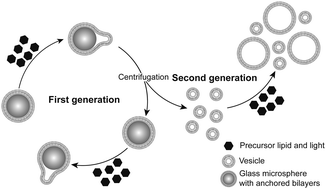Transmission of photo-catalytic function in a self-replicating chemical system: in situ amphiphile production over two protocell generations†
Abstract
Glass microsphere supported protocells were built to investigate the transmission of catalytic function during replication. The chemical system's replication was driven through in situ amphiphile production that resulted in the formation of free bilayers, the system's second “generation”. It was demonstrated that both generations, once separated, still exhibited the ability to convert amphiphile precursors. This result shows that transmission of function in chemical systems is possible during self-replication.

- This article is part of the themed collection: Systems Chemistry

 Please wait while we load your content...
Please wait while we load your content...